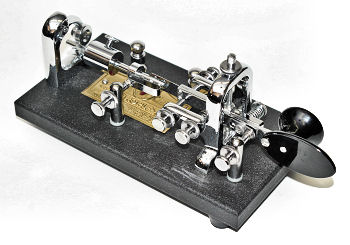Ham Radio History: The Vibroplex Morse Code key and Carpal Tunnel syndrome in the late 1800s
On Saturdays, I try to visit the weekly Hams and Eggs gathering in Carrollton (please come and join us every Saturday from about 8 AM to 10:30 AM at the Whataburger off the Prresident George Bush Turnpike at the Old Denton exit). This morning my friend Kevin N5KRG brought in an antique Vibroplex Morse code key and was mentioning a book he had read about this key which has been in continuous production for over 100 years. The key was developed to help telegraphers avoid “Telegrapher’s Paralysis” or “Glass Arm” syndrome – today we call it “Carpal Tunnel Syndrome.” From a 1997 website titled the Telephraph Office: by Neal McEwen K5RW (from here in the DFW area-I wonder if I’ve met him).
Telegraphers, making the up and down motion on their keys all day, were often the victim of an occupational hazard related to the muscles of the wrist and forearm. Today we call this malady “carpal tunnel syndrome.” In the 19th century it was called “telegrapher’s paralysis” or “glass arm.” To alleviate some of the stress, the “semi-automatic” key was invented at the turn of the century. Today we are more familiar with the name “bug” to describe the semi-automatic key. The “bug” has a lever such that when pushed to one side, the operator can make a dash similar in manner to making a dash on the older style key. When the lever is pushed in the opposite direction, the “bug” makes dots in rapid succession until the operator releases the lever. This action, besides being in the horizontal plane rather than the vertical plan, has reduced significantly, the required manipulation to form the characters of the code.
Horace G. Martin designed this key with a springy vibrating arm that automatically pulsed the circuit to send the “dots” (nowadays called “dits”) — when the arm is pressed from the left, the spring opens and closes the contacts repeatedly, allowing the operator to send one or more dots depending on how long they hold the arm (and until the spring runs out of vibration). When the arm is pressed to the right, it closes the contacts continuously (the operator still has to send the “dashes” or “dahs” manually).
Francis Remington K7GSE explains why these special keys came to be known as “bugs” (ty
In the early days a poor telegrapher was called a “bug”. and some operators bought a key from Vibroplex and other company’s and starting using them without practice. The result was poor sending, and the keys themselves became know as “bugs”. The Vibroplex Company registered the word “bug” as a trademark for its semi-automatic keys in the early 1920’s, which continues to this day. [sic]
The Vibroplex tradition continues to this day, the company is now owned by Scott E. Robbins W4PA.
(Published from DFW, Texas)

